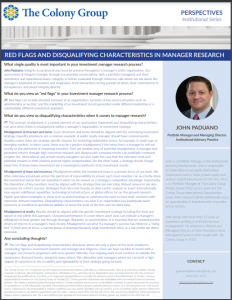Red Flags and Disqualifying Characteristics In Manager Research
What single quality is most important in your investment manager research process?
Integrity is paramount and must be present throughout a manager’s entire organization. Our assessment of integrity emerges through documented conversations with a portfolio manager(s) and their investment and operational teams. Integrity is further evaluated through reference calls where we ask about the manager’s treatment of investors and employees, their interactions during periods of stress, their commitment to transparency, and about integrity directly.
What do you view as “red flags” in your investment manager research process?
Red flags can include elevated turnover at an organization; turnover of key service providers such as administrator or auditor; and the marketing of an investment record generated under different leadership or a substantially different investment approach.
What do you view as disqualifying characteristics when it comes to manager research?
The concept of alignment is a central element of our assessment framework and disqualifying characteristics can arise when there is misalignment within a manager’s organization or investment strategy:
Misalignment of structure and terms:
Fund structures and terms should be aligned with the underlying investment strategy. Liquidity provisions are a common example. A public equity manager should have commensurate liquidity unless there are strategy-specific reasons for restricting redemption terms; for example, in small-caps or emerging markets. In these cases, there may be a greater misalignment if the terms force a manager to sell too quickly to the detriment of remaining investors. Fees are another area of potential misalignment. A manager that generates returns through high conviction research and idiosyncratic company results can justifiably command a higher fee. International and private equity managers can also make the case that the extensive work and potential rewards in their markets warrant higher compensation. On the other hand, a strategy should charge lower fees if broad index movements are a meaningful contributor to its investment results.
Misalignment of team and resources:
Misalignment within the investment team is a primary focus of our work. We often interview individuals across the spectrum of responsibility to ensure each team member can succinctly share the investment tenets that are essential to what can be viewed as a strategy’s competitive advantage. Importantly, the disposition of key members must be aligned with the strategy they are executing. Robust resources are also necessary for a firm’s success. Strategies that rely more heavily on data-centric analysis or invest internationally may require additional capabilities, technological infrastructure, or global offices for on-the-ground research. Highly specialized strategies in areas such as biotechnology or cybersecurity need to have team members with extensive, relevant expertise. Disqualifying characteristics can arise if an organization has inadequate team resources or insufficient operational abilities to serve the scale of the firm and its client base.
Misalignment of results:
Results should be aligned with the specific investment strategy including the level and nature of risk within this approach. Outsized performance in a low-return asset class can indicate a manager’s willingness to bear greater risk through leverage, illiquidity, or concentration. It is essential that we understand the drivers of returns in a manager’s track record. Misalignment can arise if a manager’s success has relied on a “rising tide” in their area of focus, a narrow group of disproportionately large investments wins, or a risk profile we deem excessive.
Any concluding thoughts?
The red flags and disqualifying characteristics discussed above are only a piece of the work entailed in conducting rigorous investment research and manager due diligence. Once we have decided to invest with a manager, our research progresses with even greater intensity. Our ongoing work must continue to validate the parameters disclosed herein, alongside many others. We ultimately seek managers where we can build a high degree of conviction in the durability and repeatability of their strategy going forward.


